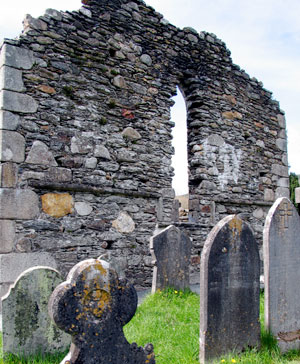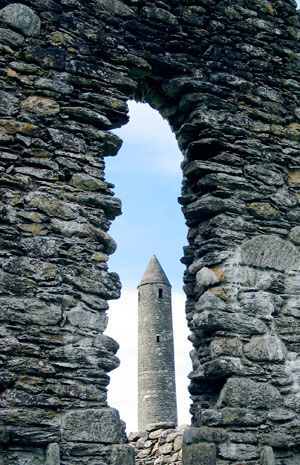GLENDALOUGH, IRELAND - You don’t have to go far in Ireland to see ancient ruins. But you will have to go a bit out of your way if you want to see the most impressive – monastic ruins that date back to the sixth century and are located in this backwater hamlet.
It was over a batch of fish and chips that a young server asked if we had plans of visiting the monastic ruins, which trace Ireland’s earliest religious roots.
A back roads drive from Dublin, through the gorse covered Irish countryside highlighted by moon-like landscape and some incredible vistas, had led us to this tiny town where a monk named Kevin, later called St. Kevin, set up shop.

Above: Graveyard dates back to the 7th century.
The monastery he built here, although often attacked by the Danes, remained intact for over 500 years and played an important role in Irish history. However, in 1214, Norman invaders brought the whole thing down, leaving only skeleton remains to be admired by today’s tourists.
“Oh, please take the time and tour the site,” the young woman encouraged us. “The walk from the car park to the ruins is just delightful. Then come back and tell me your impressions.”
A few minutes later, after downing our last ounce of Guinness, we arrived at the entrance of the ruins, which sit cradled in a tranquil valley surrounded by the legendary Wicklow Mountains.
A small bridge crosses the slow moving stream that once fed the monastery and the view of the ruins one gets from the bridge makes your heart race a little faster.
The ruins consist of a small church, a small cathedral, a small priest’s house, a small cemetery and a couple of large round towers, which are a common feature in Irish ruins but few people know what they were used for.
Some suggest they were nothing more than bell towers used to call monks and villagers to prayer while other historians say they were used by the monks to hide from invaders, which would explain why the door of the round tower was always built several feet off the ground.

Above: Glendalough translates to "valley of two lakes."
The name Glendalough (pronounced gleen-d-lock) comes from the Irish words Gleann (valley), da (two) and locha (lakes). The English translation means “the valley of two lakes.”
The Upper and Lower lakes that gave the valley its name came into existence thousands of years earlier after the Ice Age. When St. Kevin arrived, the valley was cut off from the outside world – the perfect spot for him to set up a place of learning and solitude
The valley’s fertile soil provided St. Kevin and his followers with a good life, which explains why he lived to be 120 years old – dying in 617 AD.
Despite extensive fire damage in 1163, Glendalough prospered until the 13th century. Laurrence O’Toole, Abbot of Glendalough, was appointed Archbishop of Dublin and later became Ireland’s first canonized saint.
Besides the ruins, two other fascinating places to visit while touring Glendalough are St. Kevin’s Bed and St. Kevin’s Cell, both located not far from the village’s church.
The remains of the Cell is nestled amid trees on a spur of rocks overlooking the Upper lake near a small mountain stream. The Cell is where St. Kevin would spend much of his time praying and meditating. His Bed, nothing more than a cave cut out of a rock face, is where he would retire after his long days of teaching and prayer.
Admission to the site is free and there is a gift shop at the entrance where you can buy reminders of your visit.
The site is very compact so you can tour it in less than an hour – unless you stop and read every headstone in the ancient cemetery.
We rushed back to the restaurant to tell the young server how happy we were that she’d suggested we stop and tour the Glendalough ruins.
“I’m so glad you liked it,” she bubbled. “Please tell as many people as you can to come and visit us.”
About the Author
Marc Atchison is a veteran journalist and a seasoned traveller with more than 20 years of travel writing experience. As the former Travel Editor of the Toronto Star, Canada's largest newspaper, and now Editor-in-Chief and Senior Writer for TraveLife magazine (Canada) and travelife.ca, Marc has been to over 100 countries in the world. Japan is one of his favorite destinations and he's been there on numerous occasions.